| Pages:
1
..
12
13
14
15
16
..
77 |
Metacelsus
International Hazard
    
Posts: 2539
Registered: 26-12-2012
Location: Boston, MA
Member Is Offline
Mood: Double, double, toil and trouble
|
|
@ B&F : tragic waste of iodine! 
|
|
|
Texium
Administrator
       
Posts: 4580
Registered: 11-1-2014
Location: Salt Lake City
Member Is Offline
Mood: PhD candidate!
|
|
I know! I was just thinking that too…
All the beautiful things it could have done, but it just had to go flying out a fume hood...
|
|
|
bismuthate
National Hazard
   
Posts: 803
Registered: 28-9-2013
Location: the island of stability
Member Is Offline
Mood: self reacting
|
|
 *stares mournfully at vapors *stares mournfully at vapors * *
But what did biologist want with I2? (I'm not exacly a biologist so this may be stupid)
|
|
|
Brain&Force
Hazard to Lanthanides
    
Posts: 1302
Registered: 13-11-2013
Location: UW-Madison
Member Is Offline
Mood: Incommensurately modulated
|
|
I was cleaning out a fume hood during a biology class that wasn't doing anything, so I decided to entertain the students. It was worth it, because ALL
of them got very excited. They weren't using the iodine for anything.
At the same time the iodine was being used to grow crystals inside the vial. Couldn't get any good pictures though.
And for those of you worried about the travesty I committed, there was only about .2 grams of iodine in the vial.
At the end of the day, simulating atoms doesn't beat working with the real things...
|
|
|
Texium
Administrator
       
Posts: 4580
Registered: 11-1-2014
Location: Salt Lake City
Member Is Offline
Mood: PhD candidate!
|
|
Ok then, I guess it just looks like a lot more than it actually is. That's understandable.
|
|
|
Metacelsus
International Hazard
    
Posts: 2539
Registered: 26-12-2012
Location: Boston, MA
Member Is Offline
Mood: Double, double, toil and trouble
|
|
.2 grams of iodine is still more than I have (50 mg).
|
|
|
Oscilllator
National Hazard
   
Posts: 659
Registered: 8-10-2012
Location: The aqueous layer
Member Is Offline
Mood: No Mood
|
|
Correct! (or close enough as makes no difference). It is Hexaamine nickel nitrate, shown here before drying:

I prepared it by first drying the nickel nitrate as much as possible by azeotropic removal of water using toluene. The picture below is of the Nickel
nitrate after drying. I presume it is the dihydrate, but it could be the trihydrate or even higher, I don't know. A lot of water was removed from the
nickel nitrate though, so I suspect its a fairly low hydrate.

I then removed the toluene, dissolved the nickel nitrate in ethanol and bubbled ammonia gas through the mixture, creating a beautiful precipitate of
the hexaamine complex. The precipitate was so fine some of it got through the filter, and I was unable to fully dry the sample. It is still wet with
ethanol, since I can see no way to dry it without removing the ammonia ligands
@Brain&Force I very much doubt the complex you linked is nickel Hexaamine chloride. The hexaamine complexes are unstable in air (I sealed mine in
a plastic vial glued shut) because the ammonia ligands get gradually replaced by water ones. The compound looks a lot more like cobalt chloride to me,
but of course I could be wrong.
|
|
|
Amos
International Hazard
    
Posts: 1406
Registered: 25-3-2014
Location: Yes
Member Is Offline
Mood: No
|
|
Oscillator, every step of the whole synthesis looks amazing! Maybe I'll collect Nickel compounds next...
[Edited on 6-11-2014 by No Tears Only Dreams Now]
|
|
|
Texium
Administrator
       
Posts: 4580
Registered: 11-1-2014
Location: Salt Lake City
Member Is Offline
Mood: PhD candidate!
|
|
Be careful, most are beautiful yet also very carcinogenic! Personally, I don't like keeping them around, as nice looking as they are.
|
|
|
Oscilllator
National Hazard
   
Posts: 659
Registered: 8-10-2012
Location: The aqueous layer
Member Is Offline
Mood: No Mood
|
|
Hmmm yes, I was actually thinking of doing a prepublication article on the whole process of nickel metal -> Nickel chloride -> nickel carbonate
-> nickel nitrate -> dehydration -> nickel hexaamine nitrate, since the whole process is rather fun, and the pictures are quite nice.
The only thing left to do is make nickel hydrazine nitrate, but so far my efforts have failed. The problem there is I can't figure out how to safely
isolate hydrazine from my meagre supple of hydrazine sulfate.
|
|
|
DraconicAcid
International Hazard
    
Posts: 4332
Registered: 1-2-2013
Location: The tiniest college campus ever....
Member Is Offline
Mood: Semi-victorious.
|
|
Quote: Originally posted by Oscilllator  | | @Brain&Force I very much doubt the complex you linked is nickel Hexaamine chloride. The hexaamine complexes are unstable in air (I sealed mine in
a plastic vial glued shut) because the ammonia ligands get gradually replaced by water ones. The compound looks a lot more like cobalt chloride to me,
but of course I could be wrong. |
What usually happens is that the ammonia simply evaporates; whether water replaces it or not depends on the humidity of the air.
The colour doesn't look right for the hexammine complex- it should be more purplish-blue than pink. I agree- it does look more like cobalt chloride
hexahydrate.
Please remember: "Filtrate" is not a verb.
Write up your lab reports the way your instructor wants them, not the way your ex-instructor wants them.
|
|
|
MrHomeScientist
International Hazard
    
Posts: 1806
Registered: 24-10-2010
Location: Flerovium
Member Is Offline
Mood: No Mood
|
|
Here's my preparation of hexaaminenickel(II) chloride - https://www.youtube.com/watch?v=49z5-Adw9QA
Mine was definitely purple:
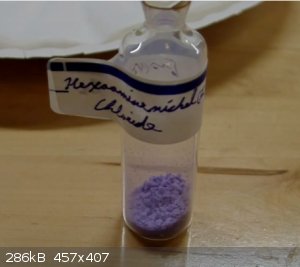
My experience too is that you can't really dry it completely - if you leave it out in air the ammonia ligands escape and it returns to regular old
green nickel(II) chloride (as seen in the video).
--------------------------------
And for my own Pretty Picture, the underside of a small "raft" of potassium sulfate crystals that formed on the surface of a saturated solution that
I'm recrystallizing from. The little pyramids formed stalactites floating on solution!
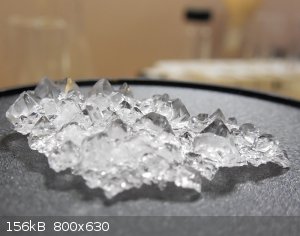
[Edited on 6-11-2014 by MrHomeScientist]
|
|
|
Texium
Administrator
       
Posts: 4580
Registered: 11-1-2014
Location: Salt Lake City
Member Is Offline
Mood: PhD candidate!
|
|
Quote: Originally posted by Oscilllator  |
@Brain&Force I very much doubt the complex you linked is nickel Hexaamine chloride. The hexaamine complexes are unstable in air (I sealed mine in
a plastic vial glued shut) because the ammonia ligands get gradually replaced by water ones. The compound looks a lot more like cobalt chloride to me,
but of course I could be wrong. |
I think it actually looks a lot more like anhydrous chromium(III) chloride rather than cobalt chloride. It has that same lustrous dark violet color,
whereas cobalt chloride is more reddish purple.
Here's a picture of some for reference:

[Edited on 6-11-2014 by zts16]
|
|
|
Brain&Force
Hazard to Lanthanides
    
Posts: 1302
Registered: 13-11-2013
Location: UW-Madison
Member Is Offline
Mood: Incommensurately modulated
|
|
MrHomeScientist: It's no longer necessary to resize photos if that's what you're doing. I personally use imgur.
It may be tris(ethylenediamine)nickel(II) chloride. Photo from woelen.
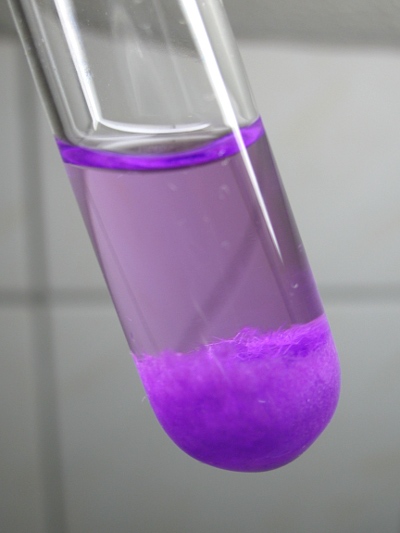
At the end of the day, simulating atoms doesn't beat working with the real things...
|
|
|
Tsjerk
International Hazard
    
Posts: 3032
Registered: 20-4-2005
Location: Netherlands
Member Is Offline
Mood: Mood
|
|
Cobalt chloride
http://commons.wikimedia.org/wiki/File:Anhydrous_Cobalt%28II...
I guessed Cobalt (II) Chloride based on this picture.
In biology by the way we use Iodine to colour starch. Bacillus transformations are often done with a DNA construct that after transfection gets
inserted in the locus for amylase by homologous recombination.
If you then grow your Bacillus on a plate with starch you can check whether your recombination was successful by using iodine. You will get a
colourless halo around the colony when it failed.
[Edited on 11-6-2014 by Tsjerk]
|
|
|
MrHomeScientist
International Hazard
    
Posts: 1806
Registered: 24-10-2010
Location: Flerovium
Member Is Offline
Mood: No Mood
|
|
B&F: Well, I like attaching photos to the posts instead of using a website link because external sources can change or disappear
over the years. There's been several old threads I've read that used to be full of interesting goodies, but the photo and document links have since
been broken. My hope is that resizing and attaching is a more permanent solution.
|
|
|
Brain&Force
Hazard to Lanthanides
    
Posts: 1302
Registered: 13-11-2013
Location: UW-Madison
Member Is Offline
Mood: Incommensurately modulated
|
|
I hadn't thought of that. But the attachment size limit is now larger thanks to Polverone; you no longer have to resize the images.
At the end of the day, simulating atoms doesn't beat working with the real things...
|
|
|
Zephyr
Hazard to Others
  
Posts: 341
Registered: 30-8-2013
Location: Seattle, WA
Member Is Offline
|
|
Quote: Originally posted by zts16  | Quote: Originally posted by Oscilllator  |
@Brain&Force I very much doubt the complex you linked is nickel Hexaamine chloride. The hexaamine complexes are unstable in air (I sealed mine in
a plastic vial glued shut) because the ammonia ligands get gradually replaced by water ones. The compound looks a lot more like cobalt chloride to me,
but of course I could be wrong. |
I think it actually looks a lot more like anhydrous chromium(III) chloride rather than cobalt chloride. It has that same lustrous dark violet color,
whereas cobalt chloride is more reddish purple.
Here's a picture of some for reference:

[Edited on 6-11-2014 by zts16] |
Anhydrous cobalt chloride is a light blue, and is only red in its hydrate form. Here are some pictures from a recent synthesis.

[Edited on 6-12-2014 by Pinkhippo11]
|
|
|
Brain&Force
Hazard to Lanthanides
    
Posts: 1302
Registered: 13-11-2013
Location: UW-Madison
Member Is Offline
Mood: Incommensurately modulated
|
|
Some potassium terbium sulfate under UV light. It's also noticeably paramagnetic. (I wonder what its Curie temperature is...)
<a href="http://imgur.com/tyB4mb7"><img src="http://i.imgur.com/tyB4mb7.jpg" title="Should I drop my remaining 2 grams of terbium metal into
a test tube of molten potassium chlorate?" width=800 /></a>
In case you didn't know, I alt-text all of my photos.
At the end of the day, simulating atoms doesn't beat working with the real things...
|
|
|
The Volatile Chemist
International Hazard
    
Posts: 1981
Registered: 22-3-2014
Location: 'Stil' in the lab...
Member Is Offline
Mood: Copious
|
|
I dunno B&F, what happens when you do that...?  (Innocent smile....) (Innocent smile....)
|
|
|
Texium
Administrator
       
Posts: 4580
Registered: 11-1-2014
Location: Salt Lake City
Member Is Offline
Mood: PhD candidate!
|
|
Here's a test tube containing copper(II)bromide complex at different concentrations, prepared from sodium bromide and copper(II)sulfate. I prepared
two solutions, one concentrated and one diluted, and then combined them in this tube. I love the way it changes colors so dramatically depending on
concentration. After swirling the tube a bit, it became a uniform yellow color.
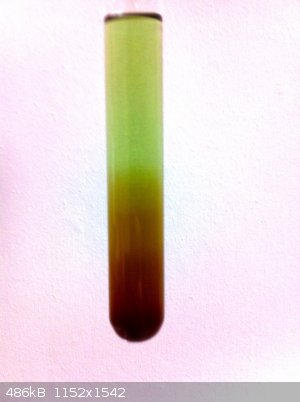
|
|
|
Zyklon-A
International Hazard
    
Posts: 1547
Registered: 26-11-2013
Member Is Offline
Mood: Fluorine radical
|
|
Iron trichloride hydrate. It's amazingly dark, will stain anything. Also quite dense.
[Edited on 14-6-2014 by Zyklonb]
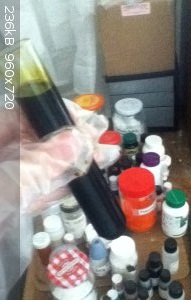
|
|
|
Texium
Administrator
       
Posts: 4580
Registered: 11-1-2014
Location: Salt Lake City
Member Is Offline
Mood: PhD candidate!
|
|
I have come to dislike iron(III)chloride, because of all of all the time I spent tediously (and in the end, unsuccessfully) trying to separate it from
manganese chloride that I had obtained form the oxides in batteries.
You're right about it staining anything. The white plastic funnel I was using during filtering is now beige on the inside.
[Edited on 6-14-2014 by zts16]
|
|
|
Zyklon-A
International Hazard
    
Posts: 1547
Registered: 26-11-2013
Member Is Offline
Mood: Fluorine radical
|
|
Yeah, it's very messy to work with.
I made it from pure iron, hydrochloric acid and hydrogen peroxide.
It's reaction with a sodium carbonate solution is pretty cool looking if you add the iron chloride solution drop by drop to the carbonate solution.
[Edited on 14-6-2014 by Zyklonb]
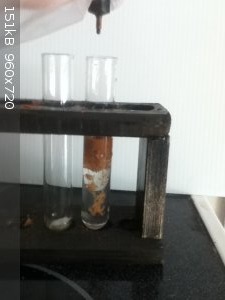
|
|
|
Brain&Force
Hazard to Lanthanides
    
Posts: 1302
Registered: 13-11-2013
Location: UW-Madison
Member Is Offline
Mood: Incommensurately modulated
|
|
I really don't like working with any iron compounds, they're all the cause of my problems. Do you know what molarity your solution is, Zyklonb?
On another note, can someone fix the image size? I'm having issues with this thread.
At the end of the day, simulating atoms doesn't beat working with the real things...
|
|
|
| Pages:
1
..
12
13
14
15
16
..
77 |